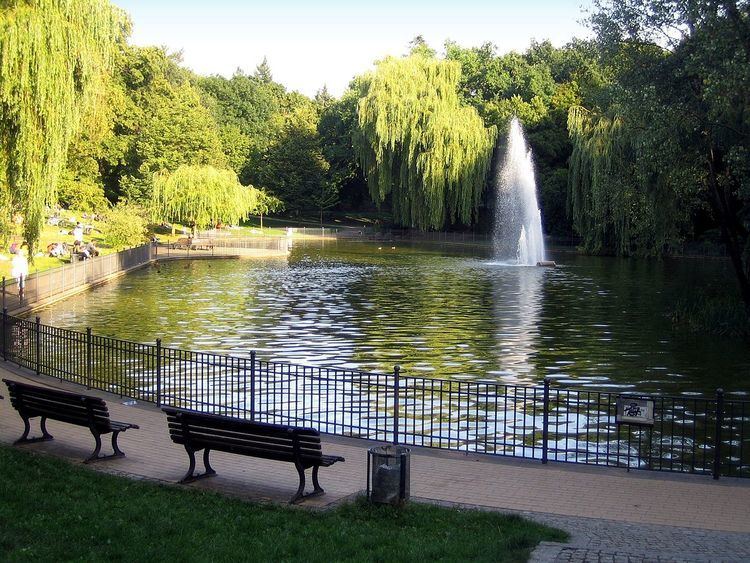Phone +49 30 25002333 | ||
 | ||
Similar Märchenbrunnen, Volkspark Humboldthain, Mauerpark, Viktoriapark, Volkspark Hasenheide | ||
Volkspark friedrichshain people s park in a berlin minute week 159
Volkspark Friedrichshain is a large urban park on the border of the Berlin neighborhoods of Friedrichshain and Prenzlauer Berg. The oldest public park in Berlin, at 52 hectares, it is also the fourth-largest, after Tempelhofer Park (>300 hectares), Tiergarten (210 hectares), and Jungfernheide (146 hectares).
Contents
- Volkspark friedrichshain people s park in a berlin minute week 159
- History
- Monuments
- The Volkspark today
- References
History
The park was originally conceived by the landscape gardener Peter Joseph Lenné, and in 1840 the Berlin city council decided to construct it on the occasion of the centennial of Frederick the Great's ascension to the Prussian throne. The oldest parts of the park were laid out in 1846-1848 based on plans by Johann Heinrich Gustav Meyer, a landscape architect who held the post of city park director, and learned his craft in the botanical garden of Schöneberg. The park was constructed on the space of a former vineyard, and officially opened in 1848 with an area of 46 hectares.
The size, shape, and layout of the park have changed over the intervening years. One of the earliest changes was due to the construction of Berlin's first urban hospital, Krankenhaus im Friedrichshain, which was built in 1868 to 1874 in the southeast part of the park. The hospital, which was designed by Martin Gropius and Heino Schmieden, was originally directed by the notable Rudolf Virchow.
An element of the park that survived the destruction wrought during the Second World War is the Fairy Tale Fountain (Märchenbrunnen). Designed in 1913 by Berlin's city building director, Ludwig Hoffmann, the fountain contains 106 stone sculptures representing characters from traditional German fairy tales. The fountain was created for the children of Berlin, during a time in which rickets and typhoid were endemic. The Second World War had a dramatic impact upon the rest of the park. The Nazi military made use of the park, constructing flak towers in 1941, as well as bunkers, and as a result much of the park was destroyed by Allied bombing during the war.
At the end of the war Berlin was divided into four parts by the Allied Powers, and the Volkspark resided in the Soviet Sector. The reconstruction of the park was therefore undertaken by the German Democratic Republic (GDR). A plan was devised by Reinhold Linger, the GDR director of landscape and park architecture, to create two small artificial mountains in the park out of rubble from the bombed-out city. (Similar projects were undertaken throughout postwar Germany, and such peaks are called Schuttberge in German.) In 1946 the bunkers were destroyed, filled, and covered by over two million cubic meters of rubble from the ruins of destroyed buildings. The larger of the two hills became known as both "Mont Klamott" and "Große Bunkerberg", the "tall bunker mountain", and is 78 meters tall. The smaller hill, "Kleine Bunkerberg", the "small bunker mountain", has a height of 48 meters. With the passage of time and the growth of greenery, the hills now appear to be completely natural features.
The park continued its evolution during the cold war. An open air theater was constructed in 1950, and after recent renovation remains open today. Two pools were constructed during the period from 1949–1951, a 5-meter deep pool for diving, and an 8-lane, 50-meter long swimming pool, along with stands for up to 8000 spectators (Karl-Friedrich-Friesen Stadium). In 1989, a Japanese Pavilion which included a Peace Bell dedicated to unity against nuclear war was constructed in between the two Schuttberge as a gift from Japan to East Berlin.
The period from 1995 to 2004 saw a period of renovation and reconstruction, during which the Fairy Tale Fountain was cleaned of a great deal of vandalism that had taken place following German reunification. The swimming pools built in the GDR period have been replaced by a sports complex for beach volleyball, rock climbing, skateboarding, and cycling.
Monuments
The Volkspark abounds in monuments. In addition to the Peace Bell, the park has monuments to Frederick the Great (historical reconstruction, completed 2000), the March Revolution of 1848, the 1918 Red Sailors' Revolution, the Spanish Civil War (designed in 1968 by Fritz Cremer), and the Memorial to Polish Soldiers and German Anti-Fascists (erected 1972, designed by Polish sculptors Zofia Wolska and Tadeusz Lodzian).
The Volkspark today
The Volkspark is a popular leisure location in Berlin, and is open 24 hours. In addition to the amenities mentioned earlier, the park has several playgrounds, many large Liegewiese (open areas for sunbathing), a pond, tennis courts, a wading pool, and a restaurant. It is also crisscrossed with paths appropriate for jogging at several difficulty levels, and in the winter months a toboggan run is opened. The Park is easily accessible using Bus number 200 from Unter den Linden, Alexanderplatz, etc.
